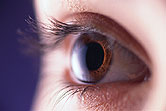
MONDAY, Feb. 14 (HealthDay News) — Obesity may be associated with reduced risk of the eye disease open-angle glaucoma in women, but not in men, a new study suggests.
Open-angle glaucoma is the most common form of glaucoma, a condition that causes damage to the optic nerve.
In the study, researchers in the Netherlands analyzed data from 3,939 participants, aged 55 and older, who took part in the Rotterdam Study and who did not have open-angle glaucoma when the study began between 1991 and 1993.
Over an average follow-up period of nearly 10 years, open-angle glaucoma developed in 108 participants (2.7 percent). The condition was most likely to occur in those who were older, had severe nearsightedness and in men, said Dr. Wishal Ramdas of the Erasmus Medical Center in Rotterdam, and colleagues.
The investigators found that, for women, there was a link between increased body mass index (BMI) and pressure within the eyes (intraocular pressure), which is a risk factor for open-angle glaucoma. However, they discovered that each one-unit increase in BMI was associated with a 7 percent decrease in the risk of developing open-angle glaucoma, but only among women.
Although the high intraocular pressure among obese women should have put them at increased risk for glaucoma, that didn’t appear to be the case, the authors noted. “High estrogen levels and hormone therapy might be protective to open-angle glaucoma, and obesity seems to be positively related with postmenopausal plasma estrogen levels,” Ramdas and colleagues wrote.
The study was released online Feb. 14 in advance of publication in the May print issue of the journal Archives of Ophthalmology.
More information
The U.S. National Eye Institute has more about glaucoma.

